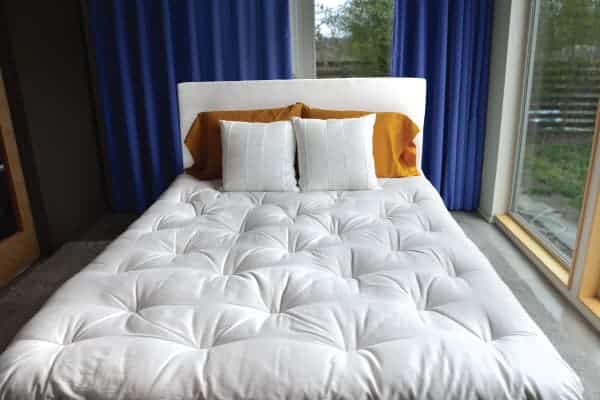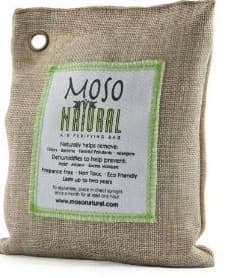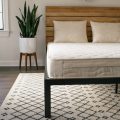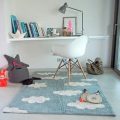
By John, Certified Holistic Health Coach
We are often asked, “I want to detox my home…where should I start?” And we almost always answer: the bedroom.
Bedrooms are a sanctuary: a peaceful, soft place…a place to lay back…a place to let everything go… a place to rest…to heal…to rejuvenate.
And yes, we spend 1/3 of our lives asleep, but let’s take a look at what that really means.
During sleep, we do much of the healing and cleanup needed to keep us functioning at a healthy level. This is why we feel so weird when we are sleep-deprived.
Evidence suggests that sleep actually clears the brain of toxic metabolic byproducts, which is why having a safe sleep environment and non-toxic bedroom is so important.
On average, we breathe about 24,000 times during an 8-hour sleep. That is 24,000 opportunities to bring in fresh air and 24,000 opportunities to release toxins.
Of course, if we are breathing in toxins while sleeping, then we are diminishing our body’s ability to detox and heal.
So, what’s so toxic about a bedroom? Unfortunately, lots, with one of the biggest concerns being the bed itself.
Toxins in Beds
Most mattresses are made from a wide variety of materials, many of which off-gas all sorts of nasty VOCs…for years! It’s hard to have a non-toxic bedroom with a conventional mattress.
For example, polyurethane foam typically contains chemicals like toluene, benzene, and formaldehyde—all of which are carcinogens. (Safer mattress materials include natural latex, cotton, and wool.)
But that is not the worst of it. Until recently, mattresses and other upholstered furnishings were required by law to contain flame retardant chemicals.
New flammability standards can be met without the use of some of worst chemical fire retardants, which are linked to hormone disruption, hyperactivity, and lowered IQ. Unfortunately, the new law does not ban the use of the chemicals, and it’s hard to know for sure which companies are still using treated foam.
This interesting bunch of chemistry easily enters our lungs and travels around the body doing all sorts of mischief, especially to our liver and thyroid.
Commonly Used Flame Retardant Chemicals
- polybrominated diphenyl ethers (PBDEs)
- tetrabromobisphenol A (TBBPA) and derivates
- hexabromocyclododecane (HBCD)
- polybrominated biphenyls (PBBs)
Flame Retardants & Children
To add insult to injury, while the negative impact of flame retardant chemicals to adults is serious, to a developing fetus or a growing child the outcomes can be far worse.
And unlike VOCs, these chemical compounds grow brittle with age and continuously shed for as long as the mattress exists! Those we don’t inhale will accumulate on the floor. When we sweep they become airborne and migrate around our homes. I know–it’s disgusting!
Oh, and get this: these chemicals are not actually all that good at preventing fires.
How to Get a Safe Mattress for Your Non-Toxic Bedroom
The solution of course, is to replace your mattress with a non-toxic one that contains zero detrimental flame retardants. Be cautious because while there are many great non-toxic mattresses, there are quite a few sneaky versions marketed to seem non-toxic. Check out our Safe Mattress Guide for help choosing a truly safe mattress for your non-toxic bedroom. You will also find information regarding organic/non-toxic crib mattresses.
The good news is that comfort need not be traded for “healthy.” Many non-toxic mattresses are super comfy and offer a superior night’s sleep.
My pick for the best mattress, and the one I am upgrading to, is this Soaring Heart Zoned Latex Mattress.
One Other Mattress Danger
Some new studies are suggesting that the metal coils in our box springs and mattresses may be amplifying ambient electromagnetic fields and are delivering this energy right into us as we sleep. I’m not convinced this is true, and more study is needed, but why take the risk when metal coils are unnecessary?
Non-toxic Bedroom 2.0
Upgrading to a safe mattress will slash your exposure to toxins, but there is more you can do–especially if you CAN’T afford to upgrade your mattress right now.
Here are some other ways to create a non-toxic bedroom:
- Invest in some non-toxic pillows. Most of the issues pertaining to mattresses also pertain to pillows. You can check out our selection of non-toxic pillows here.
- Switch to organic bedding. Sheets and comforters made from organic sources ensures that you don’t introduce pesticides and herbicides into your bedroom.
- Get a non-toxic bed frame. Bed frames and other “wooden” furniture can be made from plywood that can outgas toxins (namely, formaldehyde) for years. They may also be finished with varnishes and stains that you don’t want to inhale. Here’s our favorite line of safe frames.
- Put air filters in your bedroom. Unlike typical air fresheners, Moso’s nontoxic filters aren’t toxic to breathe, and scrub the air of VOCs. For more robust filtration, invest in a good electronic filter.
Detox with plants. Plants do double duty by absorbing airborne toxins and producing clean oxygen. Here’s a list of the best plants for air purifying, any of which will get you a step closer to a non-toxic bedroom.
- Use only fragrance-free and chemical-free laundry soap and cleaners. Make sure you aren’t tucking yourself into sheets that smell like Tide. Our Safe Laundry Detergent Guide can help you find the Good Stuff.
- Burn 100% beeswax candles. Most candles are made of paraffin wax, which creates highly toxic benzene and toluene (known carcinogens) when burned. These toxins are the same as those found in diesel fuel fumes. In the U.S., the term “pure” on a label means only 51% of an ingredient. Companies sell both “pure” beeswax candles and “pure” soy candle, which contain a combination of 51% beeswax/soy wax and 49% toxic paraffin. Use 100% beeswax candles, which have the added advantage of producing negative ions.
- Plug in a salt lamp. These can be a great candle substitute and also produce negative ions, which are known to increase serotonin in the brain.
- Don’t sweep! Instead, use a high-quality HEPA-sealed vacuum. Sweeping sends plumes of toxic dust into the air. Of course, if you don’t have any toxic furniture in your bedroom, this is less of an issue!
- Keep any electronic appliances like clocks, cell phones, WiFi routers, computers, readers, etc. as far from the bed as possible. Electronic devices emit electromagnetic radiation which some feel can be detrimental to our health. Some of these devices also emit a spectrum of light that can be disruptive to sleep. Shutting off the WiFi at night is a habit we’ve all adopted.
Sleep soundly…and sanely!
If you liked this post, sign up for our newsletter to be alerted when we publish new content like this!










angele says
How does the Plush Beds organic latex mattress rank? They are affordable and have good certifications. Also do you have any bedframe recommendations? It is so hard to find completely non-toxic bed frames that are upholstered because even if they don’t have flame retardants (Room & Board for example) they still use pressed wood, glues and polyurethane foam. Thank you for your insight.
lingencm says
Hello,
I was just wondering if you guys have heard anything about the organic line with Boll and Branch? Thank you for all of this great info! I love your site!
Maia James says
no, but will look into it!
Allie Hill says
Nothing better than Boll and Branch. I’ve tried them all and their standards just seem higher, plus the products are more luxurious. I even bought their mattress which, to me, puts the other organic beds to shame. Worth looking at their site for sure.
Robin says
John, is there any way to know or identify if household items newly purchased (namely curtains or cotton rugs post-2017) contain flame retardant chemicals anymore? I have seen the California Technical Bulletin 117-2013 label on various gifted items or while shopping (i.e. on bean bag chairs, upholstered chairs, etc.) but I had not considered if our new curtains contained them! Until I happened on an older post of yours. I’ve since laundered them in our washing machine 🙁 so of course I’m now wondering.
Thanks!
Maia James says
Hi there! your best bet is to call the company and ask. otherwise, there’s no way to know for sure, sadly!
Amanda Hat says
What about using a metal bed frame to avoid toxins in wood bed frames? Is that safe? Are there certain things to avoid?
Liz says
Also interested in this answer. I’m trying to find a bedroom set for my daughter.
Jasmine says
Can I get an answer on whether this mattress protector is safe? They claimed it is Oeko-Tex Standard 100 certified.
https://sweetzzzmattress.com/cooling-mattress-protector/